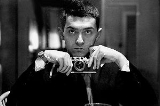
financial support for all his endeavors.
Kubrick's films are characterized by a formal visual style and meticulous attention to detail.
You sit at the board and suddenly your heart leaps. Your hand trembles to pick up the piece and move it. But what chess teaches you is that you must sit there calmly and think about whether it’s really a good idea and whether there are other, better ideas.![]()
The very meaninglessness of life forces man to create his own meaning. If it can be written or thought, it can be filmed.![]()
One man writes a novel. One man writes a symphony. It is essential that one man make a film.![]()
There's something in the human personality which resents things that are clear, and conversely, something which is attracted to puzzles, enigmas, and allegories.![]()
I have always enjoyed dealing with a slightly surrealistic situation and presenting it in a realistic manner. I've always liked fairy tales and myths, magical stories. I think they are somehow closer to the sense of reality one feels today than the equally stylized "realistic" story in which a great deal of selectivity and omission has to occur in order to preserve its "realist" style.![]()
Include utter banalities.![]()

